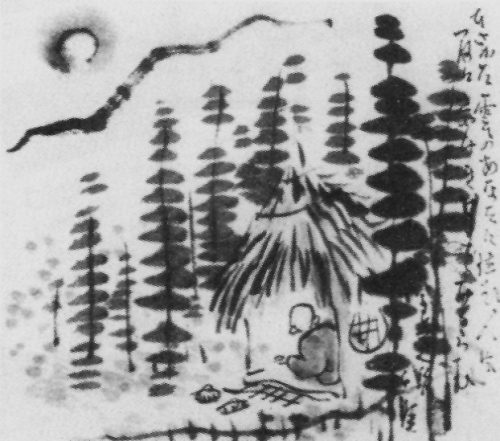Shambhala Publications: Boston and London, 1993.
$8.00 (paper).
In the “snow country” around Niigata on the northwestern shores of Japan’s main island, Honshu, the eighteenth-century Zen monk-poet Ryokan has assumed mythical proportions somewhat akin to our Johnny Appleseed. He inhabited a thatch-roofed hut among tall pines and dark hannoki alder a few hundred yards below Kokujo Temple on Kugami Mountain and lived by his begging bowl. He was revered for his personal warmth and compassion, particularly as he revealed it to children—playing games and bouncing his silk ball with them for hours on end. He referred to himself as Daiguor “great fool” Ryokan, bur he was nobody’s fool. His calligraphy was very highly prized. He once inscribed on a child’s kite, “Above heaven, big wind.”
He wrote thousands of poems and “poem-letters” that were collected and treasured by those who knew of him or encountered him as he wandered the north country. When he finally grew too old for life on his mountain, Ryokan moved to the home of a patron, only to fall in love with a young Buddhist nun, Teishin, with whom he exchanged remarkable love poems. And now they sell copies of his spidery script, along with poems and biographies and wooden carvings of the master, at the Ryokan Museum on Niigata ‘s Sunset Hill.
Poems by Ryokan have been previously translated by Burton Watson, Noboyuki Yuasa, and the present translator, John Stevens, who has also written a delightful biography (along with biographies of Ikkyu and Hakuin) in Three Zen Masters (Kodansha, 1993).

One of Ryokan’s most famous haiku runs, in Stevens’s translation: “Left behind by the thief— / The moon / In the window.” One of the problems in translating Japanese poetry into English is that the language tends to condense, losing the music of the five- and seven-syllable lines of the original. In this poem, the data are presented in proper order, but the result feels nonetheless like “translatorese,” that odd syntax so often found in translation. In Three Zen Masters, Stevens presents another version: “The thief left it behind—/ The moon/ At the window.” Since both of these books were published in 1993, perhaps it suggests the translator’s own frustration with both versions. I translated this poem: “The thief left behind / only this pale moon shining / through the window.”
Another example: a tanka, five lines measuring 5-7-4-7-7 syllables in this case. The Japanese reads:
Awayuki no
naka ni tachitaru
michiochi
mata sono naka ni
awayuki zo furu
Stevens’s translation strips the poem to bare essentials:
Within
A light snow
Three Thousand Realms;
Within those realms
Light snow falls.
Stevens is “accurate” in getting the meaning of the words translated, yet somehow that is barely enough. Watson translates the same poem:
The Three Thousand Worlds
that step forth
with the light snow,
and the light snow that falls
in those three thousand worlds
This poem is kind of a koan. In translating this same poem several years ago, I chose to attempt to clarify the context a bit while fleshing out a music that might approximate the original syllabic line:
All “three thousand worlds”
are summoned here together
by this falling snow,
this snow that lightly covers
all three thousand worlds and
more.
Stevens and I both use the repeated “snow” (awayuki, light snow), but Watson and I have repeated the “three thousand worlds” in an attempt, on my part at least, to make the Western reader unfamiliar with the Buddhist reference a little more at home with the term. And to capture the poet’s intensity. Repetition is a kind of music, as in the repetition of syllabic lines. I wanted the poem to approach incantation, as the original does.
Poetry is an oral tradition, and composition must come by way of ear, not just logos or meaning, but must include the “meaning” of melos, music. Perhaps Stevens, an ordained Zen priest and professor of Buddhist Studies in Japan, is so far inside the “meaning” of Ryokan’s poem that he sometimes misses the poetry of it.
His translations nevertheless reveal a great deal of Ryokan’s spirit and character, and the reader may trust Stevens not to add to or alter his material. He presents a Ryokan who is altogether palatable and appealing to contemporary Westerners. And while it asks a lot of us to envision a beak-nosed Zen monk disguised in a woman’s kimono dancing all night during the summer festivals, Stevens makes him fully human in his English dress:
Even if you consume as many
books
As the sands of Ganges
It is not as good as really catching
One verse of Zen.
If you want the secret of
Buddhism
Here it is: Everything is in the
Heart!
Dewdrops on a Lotus Leaf is a welcome addition to the growing body of Ryokan’s work available in English. These books are not redundant, and time spent in the company of Ryokan is time spent with a very great and noble master—a pleasure and an education.
Thank you for subscribing to Tricycle! As a nonprofit, we depend on readers like you to keep Buddhist teachings and practices widely available.